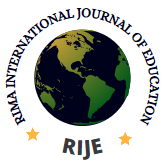The Role of Libraries in Harnessing Technology for Promoting Digital Inclusion in Nigeria
Aisha Sadiq Yelwa
Inuwa Abdulkadir Library, Sokoto State University, Sokoto
Abstract
In an era defined by digital advancement, librarians have become pivotal in driving digital inclusion efforts. This paper explores how librarians leverage technology in libraries to bridge the digital divide and empower communities. Librarians provide equitable access to technology infrastructure, offer tailored educational programmes to enhance digital literacy, and collaborate with local entities to address specific community needs. The paper highlights the innovative initiatives undertaken by librarians to promote digital inclusion, such as workshop, user education programme, online training and mobile libraries reaching areas that face challenges in accessing services, including educational and digital resources, due to their distance from urban centers, and collaborations with community centers and educational institutions. By fostering a culture of lifelong learning and digital empowerment, librarians are transforming lives and shaping a more inclusive future for all. The paper concluded that, harnessing technology is essential for promoting digital inclusion, and librarians are at the forefront of this endeavor. Their proactive leadership, expertise, and commitment to equity are instrumental in bridging the digital divide and ensuring that everyone has the opportunity to thrive in the digital age.
Keywords
Digital Inclusion, Digital inclusion and libraries,, digital inclusion and librarians, Nigerian Libraries and Technology
Reference
Agaka, S. S. (2024, June 16). Towards achieving 95 percent digital literacy in Nigeria. Nigerian tribune. https://tribuneonlineng.com/towards-achieving-95-percent-digital-literacy-in-nigeria/
American Library Association. (2023, April 5). Core values of librarianship. https://www.ala.org/advocacy/intfreedom/corevalues
Armitage, L., & Nasser, A. (2018). Metadata basics for web content: The unification of structured data and content management. Apress.
Association of College & Research Libraries. (2020, April 10). Framework for information literacy for higher education. http://www.ala.org/acrl/standards/ilframework
Ayob, A. (2020). An Assessment of the Effectiveness of Library Resources and Services in Supporting Researchers’ Information Needs. Malaysia
Bates, A. W. (2019). Teaching in a digital age: Guidelines for designing teaching and learning. Tony Bates Associates Ltd.
Bawden, D. (2020). Digital libraries and librarianship. Facet Publishing.
Bopp, R. E., & Smith, L. C. (2021). Reference and information services: An introduction. Libraries Unlimited.
Brown, S. A., & Venkatesh, V. (2021). Model of adoption of technology in households: A baseline model test and extension incorporating household life cycle. MIS Quarterly, 29 (3), 399-426
CILIP (2024, June 16). Driving digital inclusion the role of library and information
Professionals. http://www.cilip.org.uk/sites/
Davis, K. (2019). Information inequality: An analysis of the global digital divide. Georgetown Journal of International Affairs. 9 (2), 91-105
Dempsey, L., & Wilson, J. (2019). Digital literacy unpacked. Facet Publishing.
European Commission. (2019). Digital inclusion and skills in Europe: Final report. Publications Office of the European Union 2019. https://europeancommission.org/digitalinclusive/report/2019.html
Evans, G. E., & Saponaro, M. Z. (2021). Introduction to library public services. ALA Editions.
Fourie, I. (2019). Library and information services in the digital age. Chandos Publishing.
Januszewski, A., & Molenda, M. (Eds.). (2023). Educational technology: A definition with commentary. Routledge.
Helsper, E. J., & Reisdorf, B. C. (2017). The emergence of a “digital underclass” in Great Britain and Sweden: Changing reasons for digital exclusion. New Media & Society.
Hildreth, S. H. (2018, May 10). Libraries as community hubs for digital inclusion: A discussion guide. Institute of Museum and Library Services. https://www.imls.gov/sites/default/files/publications/documents/digitalinclusiondiscussionguide.pdf
Hirsh, S. (2019). The information professional’s career guide in the digital age. Chandos Publishing.
Ifijeh, G. James,I. J and Adebayo, O. (2021). Digital inclusion and sustainable development in Nigeria: the role of libraries. 3rd International Conference on African Development Issues (CU-ICADI 2016)
Internet World Stats (2022, April 10). The digital divide, ict and broadband
internet. http://www.internetworldstats.com/links10.htm
Oluyi, I. (2023). Digital literacy in Nigeria Vs unrealistic project. https://sciencenigeria.com/digital-literacy-in-nigeria-vs-unrealistic-projections/
Lloyd, A. (2022). Information literacy and illiteracies of information: A mid-range theory and model. Journal of Information Literacy, 11(1), 91-105. https://doi.org/10.11645/11.1.2185
Ministry of Budget and Economic Planning (2023, June 15). The Pathways to sustainable economic transformation and inclusion in Nigeria lie in innovative policies. https://nationalplanning.gov.ng/the-pathways-to-sustainable-economic-transformation-and-inclusion-in-nigeria-lie-in-innovative-policies-bagudu/
Organisation for Economic Co-operation and Development. (2020). Bridging the digital divide: Measuring digital skills across the European Union. Hitech library Journal. 2 (2), 20-34
Palfrey, J. (2019). BiblioTech: why libraries matter more than ever in the age of Google. Basic Books.
Public Library Association. (2023, May 10). Public library association advocacy. https://www.ala.org/pla/advocacy
Rosenfeld, L., & Morville, P. (2019). Information architecture for the World Wide Web: Designing large-scale web sites. O’Reilly Media.
Todaro, J. (2019, May 6). Mobile libraries are bridging the digital divide. American Libraries Magazine. https://americanlibrariesmagazine.org/2019/05/01/mobile-libraries-digital-divide/
Warschauer, M., & Matuchniak, T. (2023). New technology and digital worlds: Analyzing evidence of equity in access, use, and outcomes. Review of Research in Education. 17 (1), 13-26
